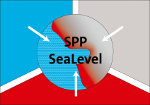project homepage: spp-sealevel.de
SEASCApe Baltic
SEA-level rise, Storm surges, and Coastal Adaptation at the German Baltic Sea coast
https://www.spp-sealevel.de/index.php?id=3818
Extreme sea levels are a major threat for coastal communities and they are expected to become more severe in a warming climate either due to rising mean sea levels or due to potential changes in storminess. This is particularly true for densely populated and microtidal environments that are particularly sensitive to sea-level changes, such as the German Baltic Sea coast. Despite this, the needed adaptation responses are poorly understood in this region due to a number of limitations. Adaptation risk management requires local statistical information on both heights and duration of extreme sea-level events, as well as on the upper tail of the uncertainty of future projections (high-end scenarios), both of which are currently not available for the German Baltic Sea coast. Another limitation is that both hydrodynamic and stylized methods for coastal flood impact assessments generally ignore the wider range of adaptation measures such as ecosystem-based protection options, accommodation options and retreat options, which are, however, essential for long-term strategic responses to sea-level rise. Finally, long-term adaptation decision making requires the application of robust decision-making methods, which are difficult to combine with the computationally expensive hydrodynamic models. Instead, stylized flood models are required, which, however are often not very accurate due to a lack of calibration.
SEASCApe Baltic addresses these limitations and presents an integrated assessment of coastal flood risk and adaptation responses for the German Baltic Sea.It analyses local scale bivariate probabilistic information on both extreme sea-levels and their duration by combining historical observations with numerical modelling for the application of multi-variate extreme value statistics, and using these information to generate return water levels under high-end sea-level rise scenarios. SEASCApe Baltic further develops improved methods for the socio-economic assessment of coastal flood impacts by combining hydrodynamic inundation modelling with protection, accommodation and retreat adaptation options. Finally, SEASCApe Baltic develops a stylized model of coastal flooding that includes a wide range of adaptation options and is sufficiently fast that it can be run within a range of suitable robust decision-making methods. The stylized model was calibrated through the hydrodynamic inundation modelling and then applied to develop coastal adaptation pathways for whole German Baltic Sea coast.
The project SEASCApe Baltic is funded under the priority program 1889 “SeaLevel: Regional Sea Level Change and Society” of the German Science Foundation (DFG).
, , , , , , et al. ( 2019). Meeting user needs for sea level rise information: A decision analysis perspective. Earth’s Future, 7, 320– 337. https://doi.org/10.1029/2018EF001071
van der Pol, T.D., Hinkel, J. Uncertainty representations of mean sea-level change: a telephone game?. Climatic Change 152, 393–411 (2019). https://doi.org/10.1007/s10584-018-2359-z
, , . The added value of real options analysis for climate change adaptation. WIREs Clim Change. 2020;e642. https://doi.org/10.1002/wcc.642





